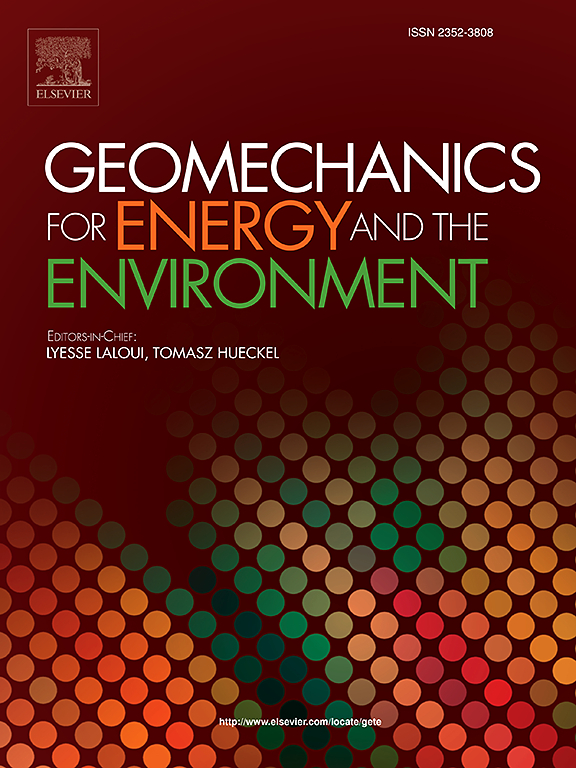Centrifuge modeling of temperature effects on the pullout capacity of jacked-in energy piles in saturated soft clay
IF 3.7
2区 工程技术
Q3 ENERGY & FUELS
引用次数: 0
Abstract
This study focuses on predicting the impacts of a heating-cooling cycle on the pullout capacity of energy piles installed through a soft clay layer. Geotechnical centrifuge physical modeling was used to evaluate temperature, pore water pressure, volume change, and undrained shear strength profiles in clay layers surrounding energy piles heated to different maximum temperatures to understand their impacts on the pile pullout capacity. During centrifugation at 50 g, piles were jacked-in at a constant rate of penetration into a kaolinite clay layer consolidated from a slurry in a cylindrical aluminum container, heated to a target temperature after stabilization of installation effects, cooled after completion of thermal consolidation requiring up to 30 hours (1250 days in prototype scale), then pulled out at a constant rate. T-bar penetration tests were performed after the heating-cooling cycle to assess differences in clay undrained shear strength from a baseline test. The pullout capacity of an energy pile heated to 80 °C then cooled to ambient temperature was 109 % greater than the capacity in the baseline test at 23 °C, representing a substantial improvement. The average undrained shear strength measured with the T-bar at a distance of 3.5 pile diameters from the pile heated to 80 °C was 60 % greater than at 23 °C but followed the same trend as pile capacity with temperature. An empirical model for the pullout capacity was developed by combining predictions of soil temperature, thermal excess pore water pressure, thermal volumetric strain, and undrained shear strength for different maximum pile temperatures. The empirical model predictions matched well with measured pullout capacities.
温度对饱和软黏土中插入式能源桩拔桩能力影响的离心模拟
本文主要研究了冷热循环对软粘土层能源桩拔桩能力的影响。采用岩土离心物理模拟技术,对不同最高温度下能源桩周围粘土层的温度、孔隙水压力、体积变化和不排水抗剪强度曲线进行了评价,以了解其对能源桩拔桩能力的影响。在50 g的离心过程中,将桩以恒定速率插入到圆柱形铝容器中由浆料固结的高岭石粘土层中,在安装效果稳定后加热到目标温度,在完成热固结后冷却,需要长达30 小时(原型规模为1250天),然后以恒定速率拔出。在加热-冷却循环后进行t杆穿透试验,以评估粘土不排水抗剪强度与基线试验的差异。加热到80 °C,然后冷却到环境温度的能源桩的拔出能力比23 °C基线测试的容量大109 %,这是一个实质性的改进。加热至80 °C时,在距桩径3.5处用t形杆测得的平均不排水抗剪强度比加热至23 °C时高60 %,但与温度变化趋势相同。通过对不同最高桩温下土体温度、热超孔隙水压力、热体积应变和不排水抗剪强度的预测,建立了抗拔能力的经验模型。经验模型的预测与实测的抽提能力吻合良好。
本文章由计算机程序翻译,如有差异,请以英文原文为准。
求助全文
约1分钟内获得全文
求助全文
来源期刊

Geomechanics for Energy and the Environment
Earth and Planetary Sciences-Geotechnical Engineering and Engineering Geology
CiteScore
5.90
自引率
11.80%
发文量
87
期刊介绍:
The aim of the Journal is to publish research results of the highest quality and of lasting importance on the subject of geomechanics, with the focus on applications to geological energy production and storage, and the interaction of soils and rocks with the natural and engineered environment. Special attention is given to concepts and developments of new energy geotechnologies that comprise intrinsic mechanisms protecting the environment against a potential engineering induced damage, hence warranting sustainable usage of energy resources.
The scope of the journal is broad, including fundamental concepts in geomechanics and mechanics of porous media, the experiments and analysis of novel phenomena and applications. Of special interest are issues resulting from coupling of particular physics, chemistry and biology of external forcings, as well as of pore fluid/gas and minerals to the solid mechanics of the medium skeleton and pore fluid mechanics. The multi-scale and inter-scale interactions between the phenomena and the behavior representations are also of particular interest. Contributions to general theoretical approach to these issues, but of potential reference to geomechanics in its context of energy and the environment are also most welcome.
 求助内容:
求助内容: 应助结果提醒方式:
应助结果提醒方式:


